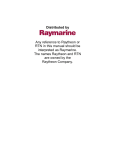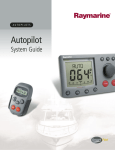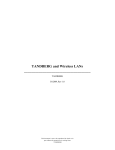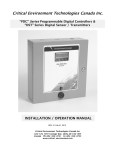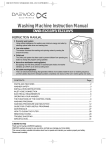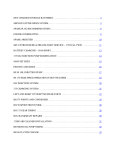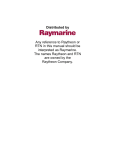Download Raymarine SPX Solenoid Installation guide
Transcript
81178_5.book Page 1 Wednesday, April 24, 2013 6:42 PM Hydraulic Pump Installation Guide Drives covered: E12139 Type 0.5 Hydraulic Pump 12 V M81120 Type 1 Hydraulic Pump 12 V M81119 Type 1 Hydraulic Pump 24 V M81121 Type 2 Hydraulic Pump 12 V M81123 Type 2 Hydraulic Pump 24 V M81122 Type 3 Hydraulic Pump 12 V M81124 Type 3 Hydraulic Pump 24 V Document number: 81178-5 April 2013 81178_5.book Page 2 Wednesday, April 24, 2013 6:42 PM 2 Important information Safety notices WARNING Intended use A properly installed and operated hydraulic pump as part of an autopilot system is designed to be used only as a backup to a vessel’s existing primary steering system. The autopilot system is NOT intended or warranted to be used as a replacement for the primary steering system. WARNING Product installation This equipment must be installed in accordance with the instructions contained in this handbook. Failure to do so could result in poor product performance, personal injury and/or damage to your boat. Because correct performance of the boat’s steering is critical for safety, we STRONGLY RECOMMEND that an Authorized Raymarine Service Representative fits this product. WARNING Navigation aid When this product is used within a navigation system, it is only an aid to navigation. It’s accuracy can be affected by many factors, including equipment failure or defects, environmental conditions and improper use or handling. It is the user’s responsibility to exercise common prudence and navigational judgements. This product should not be relied upon as a substitute for such prudence and judgement. Always maintain a permanent watch so that you can respond to situations as they develop. 81178_5.book Page 3 Wednesday, April 24, 2013 6:42 PM 3 WARNING Ensure cleanliness Absolute cleanliness is essential when working with hydraulic systems. Even the smallest dirt particle could prevent the steering system check valves from working correctly. Ensure that no dirt enters the system during the installation, and that all hoses and fittings are cleaned before making any connections. EMC installation guidelines Raymarine equipment and accessories conform to the appropriate Electromagnetic Compatibility (EMC) regulations, to minimize electromagnetic interference between equipment and minimize the effect such interference could have on the performance of your system. Correct installation is required to ensure that EMC performance is not compromised. For optimum EMC performance we recommend that wherever possible: • Raymarine equipment and cables connected to it are: • At least 1 m (3ft) away from any equipment transmitting or cables carrying radio signals e.g. VHF radios, cables and antennas. In the case of SSB radios, the distance should be increased to 7 ft (2 m). • More than 2 m (7 ft) from the path of a radar beam. A radar beam can normally be assumed to spread 20 degrees above and below the radiating element. • The product is supplied from a separate battery from that used for engine start. This is important to prevent erratic behavior and data loss which can occur if the engine start does not have a separate battery. • Raymarine specified cables are used. • Cables are not cut or extended, unless doing so is detailed in the installation manual. Note: Where constraints on the installation prevent any of the above recommendations, always ensure the maximum possible separation between different items of electrical equipment, to provide the best conditions for EMC performance throughout the installation. Suppression ferrites Figure 1 shows typical cable suppression ferrites used with Raymarine equipment. Always use the ferrites supplied by Raymarine. 81178_5.book Page 4 Wednesday, April 24, 2013 6:42 PM 4 D3548-2 Figure 1 Connections to other equipment If your Raymarine equipment is to be connected to other equipment using a cable not supplied by Raymarine, a suppression ferrite MUST always be attached to the cable near to the Raymarine unit. Water ingress Water ingress disclaimer Although the waterproof rating capacity of this product meets the IP67 standard, water intrusion and subsequent equipment failure may occur if the product is subjected to commercial high-pressure washing. Raymarine will not warrant products subjected to highpressure washing. Waste Electrical and Electronic Equipment Directive The Waste Electrical and Electronic Equipment (WEEE) Directive requires the recycling of waste electrical and electronic equipment. Whilst the WEEE Directive does not apply to some of Raymarine’s products, we support its policy and ask you to be aware of how to dispose of this product. The crossed out wheelie bin symbol, illustrated above, and found on our products signifies that this product should not be disposed of in general waste or landfill. Please conact your local dealer, national distributor or Raymarine Technical Services for information on product disposal. Warranty To register your Raymarine product ownership, please visit www.raymarine.com and register online. It is important that you register your product to receive full warranty benefits. Your unit package includes a bar code label indicating the serial number of the unit. You will need this serial number when registering your product online. You should retain the label for future reference. 81178_5.book Page 5 Wednesday, April 24, 2013 6:42 PM 5 IMO and SOLAS The equipment described within this document is intended for use on leisure marine boats and workboats not covered by International Maritime Organization (IMO) and Safety of Life at Sea (SOLAS) Carriage Regulations. Technical accuracy To the best of our knowledge, the information in this handbook was correct when it went to press. However, Raymarine cannot accept liability for any inaccuracies or omissions it may contain. In addition, our policy of continuous product improvement may change specifications without notice. As a result, Raymarine cannot accept liability for any differences between the product and the handbook. 81178_5.book Page 6 Wednesday, April 24, 2013 6:42 PM 6 Introduction Product description The Raymarine hydraulic pump (also known as the Raymarine reversing hydraulic pump) is intended to operate a vessel’s steering mechanism as part of a Raymarine autopilot system. It is primarily designed for use on vessels with an existing hydraulic steering system. Alternatively, you can use this pump on a vessel with mechanical steering in conjunction with a secondary steering ram. Raymarine pumps are driven by 12 or 24 V dc permanent magnet motors. The pumps include pilot-operated check valves that prevent the pump being back driven by the manual steering system or rudder load. The motors have an IP67 rating and can be removed from the pump without allowing air into the hydraulic system or fluid to escape. The pumps also include compatibility with balanced or unbalanced cylinders and can be used with pressurised reservoir systems. Optional reservoir port Ram ports Reservoir port Gear pump Motor Check valve Mounting foot D5175-2 Figure 2 Contents This guide contains: 1 Product specifications page 7 2 Installation instructions page 8 3 Maintenance information page 21 81178_5.book Page 7 Wednesday, April 24, 2013 6:42 PM 7 Specifications Pump specifications Table 1-1: Pump specifications Performance (at nominal voltage) Type 0.5 E12139 (12 V) Ram compatibility Ram capacity (min-max) Type 1 (T1) M81120 (12 V) M81119 (24 V) Type 2 (T2) M81121 (12 V) M81123 (24 V) Type 3 (T3) M81122 (12 V) M81124 (24 V) 230-350 cc (14-21.4 in3) 350-500 cc (21-30.5 in3) single or double ended 50-110cc (3.1-6.7 in3) Maximum intermittent pressure (at 12 V) 80-230 cc (4.9-14.0 in3) 55 bar (800 psi) Peak flow rate (no load) 600 cc/min (36.6 in3/min) 1000 cc/min (61.0 in3/min) 2300 cc/min (140.4 in3/min) 3100 cc/min (189.2 in3/min) Typical current at 12 V, 55 bar 9A 19 A 24 A 34 A Typical current at 24 V, 55 bar N/A 9A 11A 15.5 A Other information (applies to Types 0.5, 1, 2 and 3) protected for use in engine compartments CE approvals - conforms to: 2004/108/EC (EMC), EN60945:2002 94/25/EC (RCD), EN28846:1993 & EN ISO 10592:1995. IEC 60529 IP67 Pump dimensions All ports are 1/4 inch BSPP (parallel threaded) 89 mm (3.50 in) A 4 holes for M6 (0.25 in) bolts B Figure 3 103 mm (4.05 in) D5174-2 81178_5.book Page 8 Wednesday, April 24, 2013 6:42 PM 8 Table 1-2: Pump dimensions Dimension Type 0.5 E12139 (12 V) Type 1 (T1) M81120 (12 V) Type 1 (T1) M81119 (24 V) Type 2 (T2) M81121 (12 V) M81123 (24 V) Type 3 (T3) M81122 (12 V) M81124 (24 V) A 58.4 mm 58.4 mm 58.4 mm 59.5 mm 61.4 mm B 203 mm 199 mm 203 mm 204 mm 206 mm Installation instructions Parts required To install this drive you will need: • Parts supplied: • hydraulic pump • 1/4 in BSP bonded rubber / metal seals (x3) • if required: 1/4 in BSP to 1/4 in NPT adaptors (x3) • Additional parts: • suitable hydraulic pipes, hydraulic fluid, T-pieces, and pipe fittings (see page 11) • suitable securing bolts and lock nuts (see page 10) • cable and electrical connectors for the drive motor (see page 16) 81178_5.book Page 9 Wednesday, April 24, 2013 6:42 PM 9 Installation steps WARNING Electrical safety Make sure you have switched off the power supply before you start installing this product. Follow these steps to install your hydraulic pump: 1 page 3 Consult the EMC installation guidelines. 2 page 10 Mount the pump. 3 Connect to the hydraulic steering system. page 11 4 Connect to the SPX course computer or Evolution ACU (Actuator Control Unit). page 16 5 Complete the post-installation checks. page 19 81178_5.book Page 10 Wednesday, April 24, 2013 6:42 PM 10 2. Pump mounting Location requirements • pump is designed for below-deck installations only. • fit pump to a substantial structure to avoid vibration that could damage the pipes. • mount away from sources of heat and excessive vibration and fumes. • do NOT mount in confined areas containing flammable materials. • install pump above areas liable to flooding. • on a suitable surface, clear of spray and possible water immersion. • level or above the hydraulic steering ram to prevent air collecting in the ram. • as close to the ram as possible. Orientation The pump can be mounted in any orientation. If mounting vertically, position the pump in a motor-up orientation if possible. The pump has 2 reservoir ports (“R port”). In all cases, select the R Port which best allows the hose to continuously rise to the helm pump or external reservoir. The following diagram illustrates the preferred routing of the reservoir hose, based on different mounting orientations: R R R R D12808-1 Figure 4: Note: Secure the pump using M6 (1/4 inch) bolts and lock nuts. 81178_5.book Page 11 Wednesday, April 24, 2013 6:42 PM 11 3. Hydraulic connections WARNING Pressurized systems Before disconnecting any pipes on pressurized systems, you MUST release the pressure at the reservoir by following the manufacturer’s instructions. CAUTION Pump connection Before you connect the autopilot pump to your hydraulic system we strongly recommend that you consult the steering gear manufacturer. CAUTION Hydraulic systems Absolute cleanliness is essential when working with hydraulic systems. Even the smallest particle of dirt could prevent the steering system check valves from working properly. Connections overview Optional reservoir port Ram ports Reservoir port D12809-1 Figure 5 81178_5.book Page 12 Wednesday, April 24, 2013 6:42 PM 12 General guidelines • All ports on the autopilot pump are 1/4 in BSPP parallel threaded. If you need to convert to 1 /4 in NPT, use the three BSPP to NPT adaptors (supplied). Use only bonded rubber / metal washers to seal the fittings. Do NOT use tapered adapters, sealing compound, or PTFE tape. • The ram ports are the service line connections to the ram. The hydraulic hoses and connections must be of a suitable pressure rating. Refer to the Technical Specification in this document. • The reservoir port is the reservoir or balance line and MUST be connected, through a continuous rise to the helm pump lowest connection or other external reservoir. To avoid potential damage or steering failure, do NOT plug this reservoir port. The optional reservoir port on the top of the unit is an optional port to allow for the most appropriate fitting of pipes, depending on the mounting orientation of the pump. The optional port is accessed by removing the blanking plug. • All pipes used to fit the pump should match, or exceed, the specification of the existing steering system pipes. Contact the steering system manufacturer if you need more information. • Use flexible pipe to connect the pump to the boat’s steering system - this avoids strain on the pipes. • Try to keep hydraulic fluid loss to a minimum when installing the pump. This will reduce the time and effort required to bleed the system of trapped air after installation: • non-pressurized systems: temporarily fit a non-venting plug to the helm reservoir vent to minimize fluid loss • pressurized systems: • Follow the manufacturer’s instructions if you fit any T-pieces. • The reservoir hose must be of a suitable pressure rating. Refer to the Technical Specification in this document. • All hydraulic pipes should slope upwards towards the reservoir. • A set of bleed valves near the steering ram, fitted at the highest point, will allow any air to escape upwards. CAUTION PTFE tape Do not use PTFE tape or a pipe sealing compound on hydraulic pipe connections to ensure a leak-proof joint. 81178_5.book Page 13 Wednesday, April 24, 2013 6:42 PM 13 CAUTION Hydraulic fluid • Before running the pump for the first time, make sure the system contains sufficient hydraulic fluid. You will damage the pump if you let it run when ‘dry’. • Do NOT use “brake fluid”. Use only mineral-based good quality hydraulic fluid compatible with nitrile rubber hydraulic seals. • For suitable hydraulic fluid, refer to the helm pump manufacturer’s recommendations for compatibility. Also refer to the technical data provided in the technical specification section of this document. Check valves For single-steering position boats: • Consult the steering gear manufacturer to determine whether the helm pump is fitted with reversing check valves: • without check valves, the autopilot pump will drive the helm pump (sometimes referred to as ‘motoring the wheel’) instead of moving the steering ram • If the boat has a single helm pump system without check valves, you must incorporate a double pilot check valve (part number M81166). • A double pilot check valve may also be necessary on long tubing runs - otherwise tubing expansion may cause poor autopilot performance. Note: If the boat has two steering positions, it will already have check valves installed so the two wheels can operate independently. Hydraulic steering systems There are three basic types of hydraulic steering systems: • two line systems • two line pressurized systems • three line systems On the following pages typical connection points are described for the autopilot pump on each of these systems. For all of the systems you will need to connect a third hydraulic pipe (as shown) between the autopilot pump and the helm pump or system reservoir. Two line systems Figure 6 shows a typical two line steering system. Hydraulic fluid flows into the ram in either direction, depending on the direction the helm pump rotates. Connect the autopilot pump to the steering system as shown in Figure 6. 81178_5.book Page 14 Wednesday, April 24, 2013 6:42 PM 14 Helm pump Ram pipes Reservoir pipe Steering ram Autopilot pump D5163-2 Figure 6 Two line pressurized systems Two line pressurized systems have an external pressurized reservoir. This reduces the possibility of introducing air into the system and reduces any steering ‘sponginess’ caused by pipe expansion. Connect the autopilot pump to the steering system as shown in Figure 7. Note: Refer to the manufacturer’s instructions for de-pressurizing and re-pressurizing the system. 81178_5.book Page 15 Wednesday, April 24, 2013 6:42 PM 15 Helm pump Reservoir pipe Pressurized reservoir Ram pipes Autopilot pump Steering ram D5162-2 Figure 7 Three line systems In a three line system, the hydraulic fluid flows in only one direction: • out of the helm pump to the ram • returning from the other side of the ram to the reservoir via a common return line The system will include a check valve block to direct all returned fluid from the ram back to the reservoir. Connect the autopilot pump to the steering system as shown in Figure 8. 81178_5.book Page 16 Wednesday, April 24, 2013 6:42 PM 16 Helm pump Check valve Reservoir pipe Ram pipes Autopilot pump Steering ram D5161-2 Figure 8 4. Connecting to the course computer or ACU WARNING Electrical safety Make sure you have switched off the power supply before you start installing this product. The hydraulic pump has electrical connections for its motor: a red and a black cable. Note: To meet current EMC legislation, you must NOT untwist the pump cables. Follow these steps to connect the pump motor to an SPX course computer or Evolution ACU (Actuator Control Unit): 81178_5.book Page 17 Wednesday, April 24, 2013 6:42 PM 17 1. Measure the distance of cable run from the pump to the course computer or ACU, then use Table 1-3 to identify the appropriate cable sizes. 2. Join these cables to the ones on the pump using appropriate electrical connectors or junction boxes at the correct power rating. 3. Route the cables back to the course computer or ACU, taking into account the EMC installation guidelines described in this document. 4. Connect the cables from the pump to the MOTOR terminals on the course computer or ACU (see Figure 9): at this stage you can connect either motor cable to either terminal. You will check these connections after installing the rest of the autopilot system. Note: If installing the pump on a boat with mechanical steering, you need to connect a bypass valve to the CLUTCH terminals (see page 18). A POWER GROUND B SOLENOID A POWER SOLENOID GROUND B MOTOR D5171-2 Figure 9 Table 1-3: Recommended cable sizes Cable length (pump to course computer or ACU) Cable gauge (AWG) Copper area (mm2) Type 0.5 drive (12 V) up to 3 m (10 ft) up to 5 m (16 ft) up to 7 m (23 ft) up to 10 m (32 ft) up to 16 m (52 ft) 14 12 10 8 6 2.5 4 6 10 16 Type 1 drive (12 V and 24 V) up to 3 m (10 ft) up to 5 m (16 ft) up to 7 m (23 ft) up to 10 m (32 ft) up to 16 m (52 ft) 14 12 10 8 6 2.5 4 6 10 16 Type 2 drive 12 V up to 5 m (16 ft) up to 7 m (23 ft) up to 16 m (52 ft) 10 8 6 6 10 16 81178_5.book Page 18 Wednesday, April 24, 2013 6:42 PM 18 Table 1-3: Recommended cable sizes (Continued) Cable length (pump to course computer or ACU) Cable gauge (AWG) Copper area (mm2) Type 2 drive 24 V up to 3 m (10 ft) up to 5 m (16 ft) up to 10 m (32 ft) up to 16 m (52 ft) 12 10 8 6 4 6 10 16 Type 3 drive 12 V up to 5 m (16 ft) up to 7 m (23 ft) up to 16 m (52 ft) 8 6 4 10 16 25 Type 3 drive 24 V up to 5 m (16 ft) up to 7 m (23 ft) up to 16 m (52 ft) 10 8 6 6 10 16 Mechanical steering systems If you are fitting the pump to a boat with mechanical steering you will need to connect it to a secondary steering ram, along with a solenoid-operated bypass valve. This bypass valve allows you to switch between autopilot course control and manual steering. To fit to a mechanical steering system: • Use suitable hydraulic pipes to connect the pump to the secondary steering ram and a suitable reservoir. • Install the solenoid-operated bypass valve (part number: M81167) across these pipes (as shown in Figure 10). • Connect the bypass valve to the CLUTCH terminals on the course computer or ACU using at least 1.5 mm2 (16 AWG) copper cable. Note: Follow the manufacturer’s instructions for mounting the hydraulic ram and reservoir. Secondary steering ram Bypass valve Manual steering system Autopilot pump connect to CLUTCH on course computer or ACU connect to MOTOR on course computer or ACU D5172-3 Figure 10 81178_5.book Page 19 Wednesday, April 24, 2013 6:42 PM 19 5. Post-installation check WARNING Steering systems Keep clear of moving steering systems at all times. Protect moving parts from access during normal use. Check the following points after installing the pump: 1. 2. 3. 4. 5. Is the pump installed in such a way that hose lengths are kept to a minimum? Is the pump secured to a substantial structure on the boat? Have you connected a reservoir pipe between the helm pump and autopilot pump? Have you fitted check valves where appropriate? Are the hydraulic pipes made of a suitable flexible material (i.e. rubber or nylon) with a suitable pressure rating? 6. Are power cables correctly routed and securely connected to the course computer or ACU? You have now finished installing the pump. After installing the rest of the autopilot you must bleed all air from the system (see below). Note: When you have installed the entire autopilot system, you will also need to complete an autopilot steering check. Refer to the control unit handbook for more details. Bleeding the system Bleeding the hydraulic system correctly is one of the most important steps when installing the autopilot hydraulic pump. If there is any air in the system the steering will feel unresponsive, particularly when you turn the wheel to hardover. IMPORTANT: Any air in the hydraulic system will greatly reduce the performance of the autopilot and the overall steering system. Follow the helm pump manufacturer’s instructions to fill the hydraulic hoses so that the A, B & R hoses do not contain trapped air or air bubbles. The hose connections to the pump may need to be loosened to allow air to escape. The pump can now be run. Follow the set up instructions for your autopilot control head. If the pump runs but the rudder does not move, use the autopilot control head to initiate a course correction. This will start the pump. Manually turn the helm wheel in the same direction as the course correction. This forces fluid into the pump, displacing any residual air. In addition to the manufacturer’s instructions for bleeding the steering system, follow these steps to bleed the autopilot pump once you have installed and set up the rest of the autopilot system: 81178_5.book Page 20 Wednesday, April 24, 2013 6:42 PM 20 1. With the system in auto mode, press the -10 button ten times: • the autopilot pump will try to drive the rudder to port. • counter this rudder movement by turning the helm to starboard to keep the rudder stationary. • you will be able to feel any air in the helm pump: any air in this side of the pump will rise to the helm pump and exhaust into the reservoir. • continue until all of the air is out of this side of the pump. 2. Clear any air on the other side of the pump: • press the +10 button ten times. • the autopilot will try to drive the rudder to starboard. • counter the rudder movement by turning the helm to port. • continue until all of the air is out of this side of the pump. • Repeat in both directions until both sides of the help pump are totally free of air. Note: Monitor the reservoir at all times and top up with the manufacturer’s recommended hydraulic fluid as required. CAUTION Hydraulic system After installation and bleeding, leave the system for 24 hours then check for any air in the system or leaks at the joints and around the pump. 81178_5.book Page 21 Wednesday, April 24, 2013 6:42 PM 21 Maintenance On a regular basis: • check that all connections and mountings are secure. • check pipes and cables for any signs of wear or damage. • check pipes and joints for any leaks. Pump maintenance The pump contains no user-serviceable parts. Contact your dealer for more information. Motor maintenance The motor contains no user-serviceable parts. However, for the purposes of replacement or coupling examination, the motor can be removed from the pump head without fluid loss or air ingress into the hydraulic system: 1. Undo the two M6 socket head cap screws (5 mm AF allen key) and remove the motor, coupling, and water seal ‘O’ ring. 2. If the coupling is worn or damaged it will need to be replaced. Lubricate the slots with a small quantity of good quality grease. 3. If any hydraulic fluid is found in the coupling area, the pump shaft seal will need to be replaced. Refer to your dealer for instructions. 4. Reassemble by replacing the ‘O’ ring. Engage the coupling between the motor and pump shafts, ensuring that the motor locates correctly in the pump spigot. Using a low-strength thread-locking compound, replace and tighten the two M6 socket head cap screws, using 13.5 Nm torque. Note: Keep all parts clean during dismantling and reassembly. 81178_5.book Page 22 Wednesday, April 24, 2013 6:42 PM 22 Troubleshooting Table 1-4: Possible problems and their solutions Problem Possible solutions Motor does not run • Check electrical connections. • Check autopilot output. • Check fuse / trip rating. Motor runs, but no ram movement • • • • • Excessive noise • Check for air in the hydraulic system. • Check the motor for damage. • Check the security of the mountings. Check for air in the hydraulic system. Check for incorrect hydraulic connections. Check there is sufficient fluid in the system. Check that the relief is set correctly, if fitted. Check the drive coupling between the pump and the motor. • Check whether the pump has been dismantled and incorrectly reassembled. EMC servicing and safety guidelines • • • • • Raymarine equipment should be serviced only by authorized Raymarine service technicians. They will ensure that service procedures and replacement parts used will not affect performance. There are no user serviceable parts in any Raymarine product. Some products generate high voltages: never handle the cables/connectors when power is being supplied to the equipment. When powered up, all electrical equipment produces electromagnetic fields. These can cause adjacent pieces of electrical equipment to interact with one another, with a consequent adverse effect on operation. In order to minimize these effects and enable you to get the best possible performance from your Raymarine equipment, guidelines are given in the installation instructions, to enable you to ensure minimum interaction between different items of equipment, i.e. ensure optimum Electromagnetic Compatibility (EMC). Always report EMC-related problems to your nearest Raymarine dealer. We use such information to improve our quality standards. In some installations, it may not be possible to prevent the equipment from being affected by external influences. In general this will not damage the equipment but it can lead to spurious resetting action, or momentarily may result in faulty operation. 81178_5.book Page 23 Wednesday, April 24, 2013 6:42 PM 23 Product support Raymarine products are supported by a worldwide network of distributors and Authorized Service Representatives. If you encounter any difficulties with this product, please contact either your national distributor, or your service representative, or the Raymarine Technical Support Call Center. Refer to the Raymarine website for contact details: www.raymarine.com 81178_5.book Page 24 Wednesday, April 24, 2013 6:42 PM
























